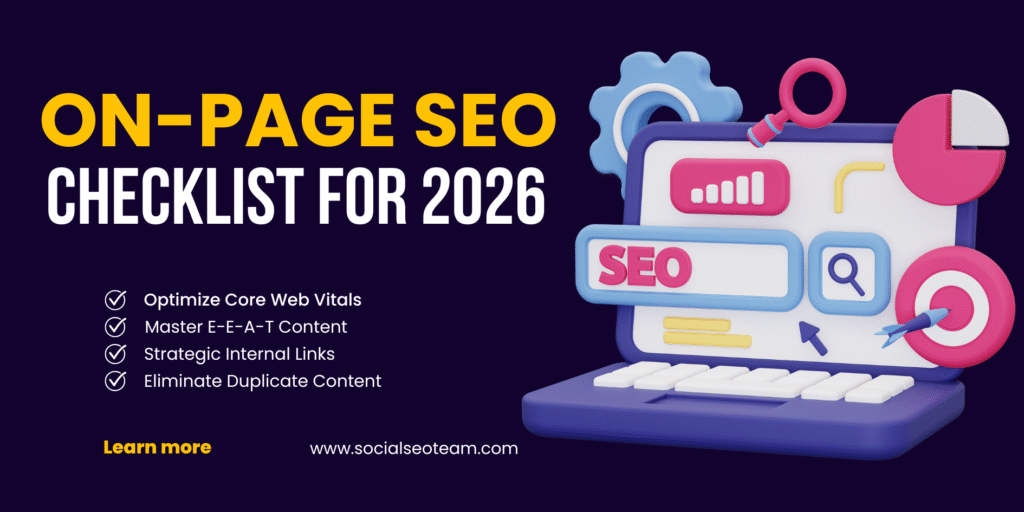To rank your website at the top of Google and other search engines in 2026, you must prioritize proper optimization for both robust Search Engine algorithms and a superior user experience.
All major search engines, including Google, publish quality guidelines for proper website optimization. Websites that follow these on-page and off-page guidelines earn a higher ranking in organic search results. On the other hand, Google dislikes over-optimized websites and pages, potentially penalizing them by pushing them down the search results rankings, which can be very difficult to recover from.
On-page Search Engine Optimization (SEO): Checklist for 2026
Stop optimizing aimlessly. Use the following on-page SEO checklist to guide your website strategy.
Get rid of duplicate content.
Search engines consider a website to have duplicate or near-duplicate content when two or more different pages in the website have the same or nearly the same content. Duplicate content is detrimental to good ranking and often leads to your website being devalued or filtered out in search engines. Even if you have used unique content on your website, duplicate content problems can arise from a few technical aspects of how your web host handles the domain. The most common cause of duplicates is when a site is accessible with and without the www. prefix. It leads to search engines detecting two web pages for your homepage. You can resolve this issue by making specific redirect changes in the .htaccess file within your hosting panel.
Follow these steps to resolve the issue: Enter the following lines in the .htaccess files (replace “domain” with your site’s name; replace “html” with “php” if relevant):
RewriteEngine On
RewriteCond %{THE_REQUEST} ^[A-Z]{3,9}\ /index.php
RewriteRule ^index.php$ / [L,R=301]
RewriteCond %{HTTP_HOST} ^www.domain.com$ [NC]
RewriteRule ^(.*)$ http://domain.com/$1 [L,R=301]
After that, log in to your Google Webmasters account and click on Settings. Then, change the preference for the type of domain: “With” or “www” www.
Get rid of duplicate meta tags.
Each page should have its own unique title. The title should accurately describe the website’s topic and be no longer than 60-70 characters (or around 600 pixels wide). Web pages with missing or duplicate titles don’t rank well on Search engines, as they can’t decide what the page is about.
Here’s how to check the duplicate meta tags on your website:
- Log in to your Google Search Console .
- Navigate to the Legacy Tools and Reports section.
- Click on “HTML Improvements.” Review the “Duplicate Meta Pages” section to identify any missing or duplicate title tags on your website.
Resolve it by creating unique and relevant title tags on your website and submitting a new site map.
Replace poor-quality content with good-quality content.
A significant focus of on-page Search engine optimization lies in creating and publishing meaningful and relevant content on the website. High-quality content always wins on search engines and has become the most critical factor for better website placement on Search engines. Your page content must be unique, relevant, and engaging to provide value to your website’s users. Crucially, content must demonstrate Experience, Expertise, Authoritativeness, and Trustworthiness (E-E-A-T). Improve page usability by incorporating interactive elements, such as images, infographics, or videos, into web pages. Furthermore, remove unnecessary code from your website to enhance the code-to-text ratio.
Get rid of any hidden content.
One of the most essential principles in Search engine optimization is that you should not utilize any shady tricks to improve your Search engine ranking. Hidden content is one of them. Hidden content is content explicitly created for Google Bots to artificially manipulate the webpage’s ranking. This content is not visible to the users. Using this trick will lead to punishment from Search engines sooner or later. Do not use the exact color text with a matching background. Note that while hiding content using elements like drop-downs or tabs (whose text content is visible in the source code) is often technically allowed, content only visible when clicking an active element may be less valued by search engines.
Audit images and add alt tags to them.
Alternative tags for images are the keyword phrases that visitors see in case the photo doesn’t load. These tags inform search engines about the image’s content, enhancing its ranking in both organic and image search results. Web admins should include relevant terms and other information in the ALT and Title tags for images.
Improve the keyword usage in the content.
Keywords are the lifeblood of any search engine optimization. That’s why proper keyword research is a prerequisite before starting any SEO campaign. You should select keywords carefully, ensuring they fit the website’s theme or the service offered. Placing keywords in prominent positions, such as paragraph headers, enhances their value and relevance. Furthermore, HTML tags such as bold, underline, and italics also enhance its importance in the eyes of search engines. Instead of focusing on an arbitrary keyword density percentage, content writers should prioritize creating user-friendly and informative content that naturally integrates semantic keywords and fully satisfies the user’s search intent. Overusing or underusing keywords for search engines can result in negative consequences.
Organize website content in headings (h1, h2, h3…)
Headers provide helpful information to search engines on the topic of a particular paragraph. Web admins should create headers carefully and use proper keywords to indicate what the paragraph or section of the website is about. There are special HTML tags to denote headers (H1, H2, H3, etc.). Web admins should use these tags according to the importance of the content on the webpage. The most critical paragraphs should be tagged with H1 and placed at the top of all other headers.
Audit and Fix Canonical Tag and URL Errors
Setting up Canonical URLs specifies the unique URL to the content of your website. It primarily avoids duplicate content on your website by telling search engines about the preferred or representative URL of the webpage. Since a website is accessible with and without www, use a canonical URL to set the representative URL for your website. Google Webmaster Tools has a dedicated section on canonical URLs, including their use and how to specify them. For more details, visit: https://support.google.com/webmasters/answer/139066?hl=en.
Proactively Manage All On-Page Elements and Site Performance
Simply placing a website on the internet and then failing to properly manage and update it regularly is negligent and can result in a decline in search engine rankings. You must periodically update your webpages with fresh and relevant content, while also maintaining the technical aspects and structure of the page. Ensure there are no duplicate titles or meta descriptions, clean up any broken links, and create a high-quality 404 error page and 301 redirects. Failing to manage the website regularly will increase clutter and errors and decrease the quality of your website.
Review and Optimize Internal Link Anchor Text
Create a uniform internal link structure and link all pages to it. Google determines the importance of a page on a website based on the internal links pointing to the webpage and the number of pages linking to it. Ensure that you link pages that are directly related to each other, as this will help search engines determine the relevance of the content. Don’t link to irrelevant pages.
Strategically Manage Link Attributes (Nofollow, Sponsored, UGC)
When acquiring or earning external links or backlinks, ensure they are as relevant to your website’s niche as possible. Backlinks from untrusted and non-relevant websites can dilute the authority of your website’s links. You should obtain both dofollow and attributed (rel= “nofollow”, rel= “sponsored”, rel= “ugc”) links. Creating a link profile solely of dofollow links can appear unnatural and lead to a Google penalty. You must use rel= “sponsored” for any paid or affiliate links and rel= “ugc” for links in user-generated content (like forums or comments).
Optimize Core Web Vitals and Enhance Page Performance
No one likes a slow webpage, and the same is true for search engines. Usually, if a page doesn’t load within 1-2 seconds, visitors just click back and look for other websites; that’s why Google considers it as one of the search engine ranking factors. Optimized Core Web Vitals—including Largest Contentful Paint (LCP), Interaction to Next Paint (INP), and Cumulative Layout Shift (CLS)—are essential. Typically, unnecessary scripts, unoptimized code, and uncompressed images and JavaScript contribute to slow page load times. If possible, create webpages using gzip compression or mod_deflate if your hosting supports these compression methods. To check if your website has a slow load time, use Google’s PageSpeed Test. It provides a detailed analysis of your website’s loading speed and offers suggestions on how to improve its loading time.
Google web page load speed test: https://developers.google.com/speed/pagespeed/
Generate and Submit Current XML Sitemap to Search Engines
XML sitemaps help Google and other major search engines understand the structure of your website and index all the pages correctly. Without a sitemap, search engines may not find some new pages, which can delay their indexing. Hence, it’s advisable to provide an automated sitemap.xml in your website root directory. Generally, the map is automatically recognized by search engines and taken into account. You can also submit it to the Google and Bing web admins’ accounts.
Review and Correct Robots.txt Directives
Use the robots.txt file to manage the crawl budget and instruct search engines to block non-public directories from crawling. Admins typically use this for the admin area, staging sites, and non-essential script folders. Do not use robots.txt to prevent indexing; for that, you must use the noindex meta tag on the page itself. Once you have created the robots.txt file, you should upload it to the root directory of your website and include only the paths you don’t want to be crawled by Search engines.
We hope this checklist provided a helpful overview of the most essential on-page SEO tasks. We’ll soon publish detailed guides covering every task in this checklist. The following post will discuss the most common mistakes and basics of off-page SEO and Link building.




